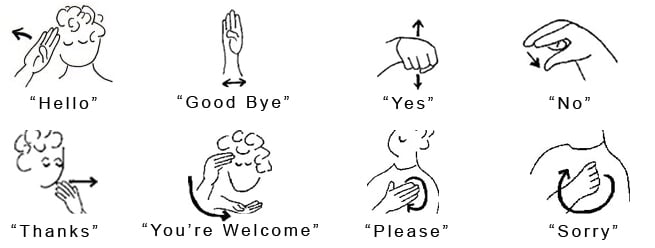AMERICAN SIGN LANGUAGE
American Sign Language in the United States
American Sign Language is one of the fastest growing languages requested in the United States today. American Sign Language, also known as “ASL”, is a complex visual-spatial language that is used by the Deaf community. It is the native language of many Deaf men and women, as well as some hearing children born into Deaf families. ASL linguists acquire various certifications through a specific educational and testing process. Certifications have 5 specific levels based on testing and desired mastery level. The levels are scaled 1-5, with 5 being the most advanced level. Another type of certification which exists separately from ASL is called Certified Deaf Interpreter, “CDI”. CDI interpreters are signers who happen to be Deaf or Partially Deaf themselves. They go through similar educational, testing and certification process as ASL interpreters do.
American Sign Language Traits
ASL shares no grammatical similarities to English and should not be considered in any way to be a broken, mimed, or gestural form of English. Some people have described ASL and other sign languages as “gestural” languages. This is not absolutely correct because hand gestures are only one component of ASL. Facial features such as eyebrow motion and lip-mouth movements as well as other factors such as body orientation are also significant in ASL as they form a crucial part of the grammatical system. In addition, ASL makes use of the space surrounding the signer to describe places and persons that are not present.
Is American Sign Language Utilized Worldwide?
Sign languages develop specific to their communities and are not universal. For example, ASL in America is totally different from British Sign Language even though both countries speak English. When a Deaf person from another country is in an exchange of vocabulary: Comments will invariably come up such as, How do you sign this How do you sign that Most sign languages develop independently and each country has their own sign language, therefore, various countries signers can not communicate with each other easily. Worldwide there are at least 121 distinct types of sign languages utilized.
CART (Communication Access Realtime Translation)
The instantaneous translation of the spoken language into text and displayed in various forms. English text is produced with less than a two-second delay. For example, a CART writer sits next to a student in a classroom and listens to the professor, transcribing all that is heard, and the English text is being displayed on the computer screen so the student can read along.
Onsite CART be provided for meetings, classes, training sessions and special events.
Remote CART is exactly the same as onsite CART except the provider is in a remote location and listens to an event through the use of a telephone or Voice-Over IP (VOIP) connect.
See ASL and CART Services by City
Samples of American Sign Language
























